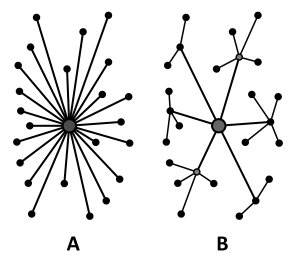Business models are highly irreversible and cannot be altered every day. Likewise, the primary supply chain models aligned to the business model cannot be changed abruptly & frequently. A business model coupled with the suitable supply chain model forms an integral part of a success story. These also include a crucial part of the Decentralisation of Warehousing for Business continuity plans for the organizations.

Photo by Adam Aladdin, CC BY-SA 3.0, Wikimedia
The Warehouse Network design or warehouse configurations form the building blocks of a successful supply chain model and are generally seen as centralized (Figure 1A). All products are shipped from one primary location. decentralizing (Figure 1B) is a method of maintaining several smaller warehouses spread out to different areas to serve other markets better or stocking different products.
Each method has its advantages and disadvantages. While Centralised warehousing rest in premises of reduced operating cost enhanced customer service, it also faces increased shipping cost & a Lack of addressing Emergencies. Whereas Decentralisation of Warehousing builds its belief on enhanced speed to the customer, thereby faster deliveries and some positive impact on sales, it potentially increases the overall operating cost of the supply chain.
While no single rule of storage & distribution fits all the organizations alike, the perception of decentralized warehouse setup increasing overhead and complexity has long left companies to bring resources into a central location. Further, the recent regulatory changes like the implementation of GST and improved transport infrastructure, etc., tilted the action towards centralizing warehouses.
However, the Covid crisis has caught the Centralised Warehousing model off-guard for being incapable of addressing emergencies. The situation has also resulted in recognizing the warehouses as a crucial part of the business models and warehouse workers, along with the delivery and retail workers as essential workers. Occurrences such as these would shift the balance of supply chain models towards a Decentralisation of Warehousing system. This further gets reinforced by the fact that with the technology at the helm of affairs and the rise of robust data collection and integration tools, the perceived challenges associated with Decentralisation of Warehousing are almost eliminated. This shall allow organizations to rethink their supply chain network and include the spreading out of their inventories to a decentralized network in a strategic way.

Photo by alireza mahmoudi on Unsplash
As the events unfold, the structure of the distribution model is likely to change further as the buying behaviors of the consumers are changing due to a host of factors, including technology, ecommerce, and now Covid19. In the emerging context, it would not be unfair to say that you may have the best product in the world, but if you can’t seamlessly distribute it to consumers, you’re already behind. So, it will be more critical for brands to be on time to reach the consumer rather than being cheap. Delay in getting your product to the customer does not remain about lost profitability but defines business sustainability. Customers would undoubtedly be at the crossroads to think and decide between efficiency and effectiveness or an optimum balance. This also means that the Micro fulfillment, along with the Last-mile delivery, will become the battleground for retailers and brands alike. Someone who is optimally spread out may win the battle!
 Mr. Mansingh Jaswal contributes to this article. A corporate executive turned Serial Entrepreneur & an Angel Investor with over 20+ years of experience in Supply Chain, Logistics, Transportation, and International Freight and a Research Scholar in Strategy at Management Development Institute (MDI), Gurgaon.
Mr. Mansingh Jaswal contributes to this article. A corporate executive turned Serial Entrepreneur & an Angel Investor with over 20+ years of experience in Supply Chain, Logistics, Transportation, and International Freight and a Research Scholar in Strategy at Management Development Institute (MDI), Gurgaon.

Leave A Comment